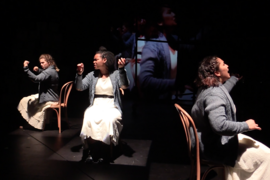Adapting a story — from page to screen, or from biography to fiction — is a precarious process, as a narrative is reinvented in the translation from one medium to another, often radically different medium from the original.
Junior Ivy Li, a double major in literature and physics, navigated a particularly gnarly adaptation process recently while studying one of the legendary works of English literature.
Edmund Spenser’s "The Faerie Queene" is a phantasmagoric adventure, a 16th century epic poem by a contemporary of Shakespeare. It’s also immense, stretching over six books of challenging material. In course 21L.705 (Major Authors: Avatars, Allegory, and Apocalypse in Spenser’s "Faerie Queene") MIT students wrangle with understanding, and ultimately transforming, this monumental work.
Professor Mary Fuller, who teaches 21L.705 and heads the MIT Literature section, explains the historical background for her students’ 21st century creative engagements with "The Faerie Queene": “From 1596 on, Spenser’s readers have been interacting with the poem to produce new paratextual material: tools to navigate and understand the text, adaptation in other genres and media, additions to a work that is both massive and notoriously unfinished.”
This tradition of “active reading,” which both elucidates and expands a story, is the basis of Fuller’s course; her students work to contextualize Spenser’s many-layered narrative. Written at the dawn of a nascent British Empire struggling to find its national identity, the text is a successor to medieval chivalric romance, and has since seen sprawling use in fantasy genres and modern allegory. It’s a famously meandering story rife with knightly quests, flexible gender roles, sharp comedy, and political argument.
Li says Spenser’s epic poem “is essentially an alternate-universe fan fiction,” the story of King Arthur “before he was king: a virtuous man is destined for glory, but he needs to wander a bit first.”
Each week, the students in Fuller’s class plot the roaming, narrative arc of the poem, visually storyboarding and mapping the movement of characters and events through the story’s six books. The coursework includes research presentations and analytical writing, alongside what the syllabus calls “a modest amount of creative work.”
Li took that creative charge above and beyond. Pouring 70 hours of work into the creative final project over “a two-week drawing binge,” Li produced a detailed, stylized, and striking visual comic adaption of a particularly difficult portion of The Faerie Queene’s fourth book.
“Using roughly a tenth as many words as the original,” writes Professor Fuller, “[Li’s adaptation] makes shapely narrative from a part of the poem that used to be considered incoherent and obscure. Ivy also makes sure you get the jokes.”
For Li, the study of both literature and physics is based in a deep aesthetic appreciation of the universe and the human condition.
“Physics and literature both search for explanations to the universe around us,” writes Li, “one through mathematics and experimentation, the other, through words. The fact that there's some fundamental truth that can be explained through human language is incredible to me.”
Participating in the MIT Arts Scholars program, and serving as an arts editor for The Tech, MIT's student newspaper, have also provided Li opportunities to develop a deeper understanding of the literary and visual arts, including the comic medium which Li has long admired for its malleable, interdisciplinary nature.
“Since childhood, I’ve been passionate about comics because they tell rich stories by blending elements of different media,” Li says. “Requiring the skills of a playwright and a cinematographer, the comic book medium sits snugly at the intersection between text and visual art.”
Li began honing that skill as a first-year student, jumping at the opportunity to take 21W.744 (The Sweet Art of Comic Book Writing), taught by acclaimed author Marjorie Liu. The class — technically a specialized genre fiction workshop — takes students on a survey of a wide variety of comics, from indie web comics to big corporate print titles.
During that far-ranging sampler, students explore questions of gender, race, ethnicity, and sexuality in narrative, and have a chance to create their own short scripts and comic book stories. Liu, the first woman to win the Eisner Award for Best Writer, the comic industry’s top writing prize, is the writer behind Black Widow, Astonishing X-Men, and most recently Monstress.
The Faerie Queene adaptation project provided the next creative frontier for Li: “At MIT, I have done some illustration and comic strip work for The Tech, but I had never before worked on something of this length and scale. I was excited yet nervous for my first full-page comic project.”
Li studied, drafted, and experimented with layouts and character designs, working from reference images of horses and knights as well as human anatomy. The project was still in full swing when the class deadline brought it to a close. Even after Li put down the fountain pen, however, the mental revising and improving continued.
“Creative work enriches my literature experience,” Li reflected, several weeks after finishing the massive endeavor, “bringing me greater insight into a work’s meaning. The magic of adaption is that interpreting a work through another medium sheds an interesting new perspective while maintaining the integrity of the original.”
Ivy Li's complete adaptation from the fourth book of Edmund Spenser's "The Faerie Queene" is available as an online digital book, accompanied by commentaries from Li and Mary Fuller.
Story prepared by MIT SHASS Communications
Emily Hiestand, editorial director
Alison Lanier, senior communications associate

![“Using roughly a tenth as many words as the original,” writes Professor Fuller, “[Li’s adaptation] makes shapely narrative from a part of the poem that used to be considered incoherent and obscure. Ivy also makes sure you get the jokes.”](/sites/default/files/styles/news_article__image_gallery/public/images/201903/1400_FQ-Frames-Ivy-Li-1.jpg?itok=UlX0IVRi)








